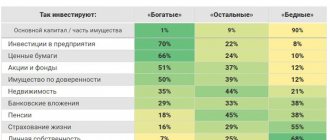You will learn who investors are and how they earn money, what to do to become a successful investor and what starting capital is needed for this. We will also talk about the main mistakes of novice investors and how to act to prevent them.
Deposit rates in Russia are falling, and even a deposit at 6% is considered profitable. Are you not happy with these conditions? Then this article is for you.
Elena Zaitseva, financial consultant and practicing investor, is with you. I will talk about profitable and affordable options for investing funds and give detailed instructions on how to start successfully investing from scratch.
Read to the end - a bonus will be an overview of the main mistakes of beginners, because of which, instead of profit, a loss is obtained.
How to earn passive income on websites
How to buy a website with income and receive from $10 to $3000, even despite the pandemic and its consequences. How much does a profitable website cost and how to start investing with 10,000 rubles or more in your pocket
More about the course
What is investing
To contents
This is making a profit without spending a lot of time and effort. This type of passive income does not involve physical labor, but at the same time it allows you to increase your financial resources. Investing is an investment in a comfortable future, allowing you to avoid financial problems in the future.
The most popular myths about investing:
- The investor must receive specialized education and be experienced in entrepreneurship. This will not hurt, but logical thinking, patience and the desire to understand economic processes are more important. If you have no interest in delving into the construction of financial pyramids or the fluctuation of quotes, you can only use bank deposits with the lowest risks.
- Investing can only be done by wealthy entrepreneurs. This is wrong. Investments are available to anyone. For example, a thousand rubles invested in the purchase of foreign currency can bring a good profit after a while.
- All transactions have increased risk. When using any investment method, the investor really takes risk - sometimes less, sometimes more. But there is no guarantee that the organization where you work for hire will not go bankrupt.
Investment income has no limits. They are “like children” - no one ever feels like they can afford them. But in reality they are available to everyone. Start investing small amounts and slowly move towards your goal.
How much starting capital is needed?
You don't have to start with millions of dollars in investments. In reality, the numbers are much more modest. For example, to purchase mutual funds it is enough to have 5,000 rubles, and 1,000 is enough to purchase shares.
You don't need a lot of starting capital to invest. But the larger the amount invested, the higher the potential return.
Start with 50-100 thousand rubles. This amount is enough to understand the basic rules of the market in practice, and if successful, the profitability will be tangible. But don’t invest all your capital at once at the start. When experience is insufficient, the risk of losing the invested amount is maximum.
Start with small amounts, placing them in different instruments. This way you will find the best investment options. And then, when you gain confidence, increase your investment.
What are the prospects for investing?
To contents
You can earn money using two methods: active and passive. The first involves linking income to labor and time expenditure, so it has limitations. However, no one can guarantee that in old age you will receive pension payments from the state on which you can live.
The passive method is the activity of an investor. It makes it possible to gain financial independence, not to work “for someone else” 10 hours a day, but to engage in self-education, creativity, and travel. And if you approach learning wisely, it is accessible to everyone.
"Curious Investor"
He is interested in everything, doubts everything. Today he wants to create a children's creativity studio, tomorrow - a chain of barbershops. At the same time, he is afraid to risk money. The majority of “inquisitive investors” grew up in the “roaring 90s”, so such an investor knows everything about business. As a student, he himself worked as a merchant - he sold everything he could: from nesting dolls to ice cream. But it never turned into his own business.
At the same time, it is unlikely that it will be possible to captivate the “curious” with the idea of investing in a “company that will change the world.” The main thing for him is to be guaranteed to receive his income in a short period of time. This is why he is more of an “investor” than an investor.
“Inquisitive investors” in the market, in my opinion, are about 40%. They come to crowdinvesting sites on their own, register themselves and make the first investments, having first carefully studied the founder’s background and without turning to consultants.
I have asked “curious” people many times: isn’t it scary to rely only on yourself? And usually I received the answer: “Your own intuition is more important. A consultant may recommend investing in some fast-growing market, but many projects “shoot out” from industries that no one has bet on at all.” An investor of this type is ready to move in any direction, it doesn’t matter whether it’s medicine or medicine. After all, he is “inquisitive.”
How to work with it
Such investors have potential. But you most likely won’t get much benefit from them; you shouldn’t specifically look for them in the crowd. Ask if there are any professional investors and entrepreneurs among his acquaintances - in this regard, the “inquisitive investor” may surprise you.
Nine ways to invest for beginners
To contents
How to start investing right now? Explore the most promising areas for beginners and save start-up capital by creating a personal investment fund.
Bank deposits
This is the easiest way with low risks. Citizens' deposits up to 1.4 million rubles are insured by the state. In addition, many banks allow small amounts to be deposited, and the amount and period for receiving income are known in advance. But the profitability here is low. Today, rates on most deposits in rubles are no more than 7–8 percent. This investment method works better in the long term and protects savings from inflation.
You should take into account not only the deposit rate, but also other investment conditions: the presence of capitalization, the availability of early preferential withdrawal, the systematic payment of interest.
Currency: fiat and crypto
It is believed that the investment portfolio should contain funds in various currencies: national, US dollars, euros, cryptocurrencies and others. This way you will not incur heavy losses due to exchange rate changes. But this is still a rather high-risk option, and also requires constant monitoring of rates.
Real estate
Many people dream of buying an apartment in a metropolis for rent or resale after renovation. But you need to understand that such an investment also has a lot of expenses. According to experts, in 2020 there will be no benefit from purchasing “squares” in order to make money on rising prices. And if you rent out an apartment, the annual investment return will be slightly higher than on a bank deposit (8–10 percent), and the landlord will spend a lot of time and nerves.
Precious metals
A beginner can invest money in precious metals: gold, silver, platinum, palladium. Typically, such an investment is profitable in the long term.
To invest in precious metals, you can use one of the following methods:
- purchasing bars or coins;
- creation of a metal account - an analogue of a bank deposit, but without state insurance;
- investing in shares of mining companies.
To implement the first two options, you need to contact the bank. And the latter implies the choice of a broker, because individuals in the Russian Federation do not have the right to make independent investments in the stock market.
Securities: bonds and shares
Smart investments in the stock market will bring here an income of 20 percent per annum . For a novice investor, the best start would be to buy “blue chips” - securities of large enterprises that have ensured stable financial growth. Such assets are rarely unprofitable. And often they also provide for dividend payments to shareholders every 6 or 12 months.
Mutual investment funds (UIFs)
You can entrust your finances and investments to mutual funds that engage in trust management. The profit received is distributed among investors, and they charge a commission for the provision of services. By investing in mutual funds, you can hope for a return of 20–30 percent per annum. When choosing a fund, pay attention to commissions, investment objects and the smallest deposit amount. 1000 rubles is enough to invest , but more often funds require 5–10 thousand .
Own business, startups, internet projects
Any of these options, if successful, will bring big profits. But these are also the highest-risk areas. A good tip for a novice investor would be to invest a small amount in a startup that is related to the provision of services and the Internet. Today, online stores, distance learning schools, and paid mobile services are relevant and quickly pay for themselves.
Forex market
This direction is also associated with risk. You cannot become a trader without having the appropriate knowledge base. First, you need to study technical and fundamental analysis, learn to understand market indices, and practice trading on a demo account. Be sure to familiarize yourself with general Forex market concepts and trading techniques before you begin.
At the start, you should prefer PAMM investing, that is, entrust funds to a professional trader. In fact, this method is an analogue of a mutual fund. If you include 5–7 PAMM accounts in your investment portfolio, you can achieve a return of 50 percent per annum.
Binary options
Investing in them today is one of the most common options for making money online. Binary options, first of all, are attractive because they are accessible to both stock trading specialists and complete beginners. But at the same time, they allow you to carry out transactions with securities of reputable global holdings, as well as reliable investment objects: oil, gas, precious metals.
Compared to Forex, trading binary options is much easier. But at the start it is better to work with a trustee. If you act independently, then due to an incorrect bet the possibility of losing money increases significantly.
Course selection criteria
While preparing the material for this article, I realized how popular and profitable the niche is – investment courses. How can a beginner navigate the huge number of financial market gurus? They appear like mushrooms after rain against the background of the economic crisis, low levels of financial literacy and general dissatisfaction with the life of Russians.
I advise you to start learning from scratch by developing a basic foundation of financial knowledge. To do this, it is not necessary to sign up for expensive trainings or seminars. There are many books on investing, read a couple of them. You will understand how a competent investor should think and act, what investments are and what tools exist to increase your initial capital.
With an initial amount of theoretical knowledge, you can already make your first attempts at independent investments. So to speak, “test by combat.” Some do just that - learn from their mistakes, gain experience, lose and earn again. But this scenario is not for everyone.
For anyone who wants to approach investing fully equipped, I recommend spending a few more weeks or months learning from professionals. This will help reduce the risks of losing money and disappointment. The range of prices for courses is large: from a couple of thousand to several tens of thousands of rubles. There is also free, but no less effective, online education. I will talk about it separately.
Let's figure out what you need to pay attention to when choosing courses.
- Authority of the site
This means who the organizer of the training is, what relation he has to the economy in general and to investments in particular. For example, there are world-famous online educational platforms Coursera, EdX and OpenLearn. They host the best courses on finance and investment from leading universities in the world in English and Russian. Many of them are free, but sometimes you have to pay for a certificate if you need one.
Agree that the authority of such organizations as the University of California, Michigan, Yale or Illinois University, the Higher School of Economics, is not disputed by anyone.
If the training is conducted by the Moscow Stock Exchange or the country's leading brokers, then there will be a lot to learn from them. Training from private investors who have several million rubles in their accounts from investments, and not from grandmother’s inheritance, will be an excellent start in acquiring a very useful skill - investing.
- Course program
For beginners, lessons on the basics of financial literacy are suitable; for advanced students, a more difficult level is needed.
17.06.2020
91
35 best financial literacy courses for adults and children
Hello, friends! I am convinced that increasing the financial literacy of the population should become...
My main criterion when choosing any courses, not necessarily on investing, is the presence of practical classes with feedback from the teacher. Only this format gives maximum results when you are already in free swimming.
- Teaching Staff
Any self-respecting resource publishes information about teachers: their education, experience in financial markets, achievements in the field of investing, etc. In this case, it is sometimes better to trust a practicing financier and his online blog than an emeritus professor at a leading university who has not invested not a single ruble, but he knows better than anyone how to do it.
Sometimes financial and investment analysts, who are also course teachers, post the results of their investment portfolios over the past years and share investment strategies. I pay attention to them first of all, and not to the one who wrote that he earned 500% profit on his investments in 2020. Where is the evidence?
- Free webinars and articles
You can get to know the speakers and authors, and roughly imagine how and what they can teach. If the entire webinar tells you how great it is that we are all here today, and how great it will be when you buy their courses, then run right away. I give 99% that the same water will flow in paid classes. Many authors give you the opportunity to watch a video lesson or even several for free to evaluate the quality and style of teaching.
Step-by-step investing instructions for beginners
To contents
To work in this field there is no need to have a diploma from an economics university or experience in trading on the stock exchange. However, you need to know important terms and techniques. To gain knowledge, you can systematically participate in webinars, read the recommendations of famous investors, and read relevant literature. The Internet offers free investing lessons for beginners. But be careful, there are also scammers who promise to sell a “super scheme for high income” or invest in a project at “100 percent per annum . Remember, "Loot" .
The real path to future wealth consists of seven steps.
Step one. Get your finances in order
Money for future investments should not be encumbered with obligations and be essential funds. Loans from banks or other credit organizations as invested finance In the event of negative developments, losses will increase not only by the invested amount, but also by the loan used plus interest on it.
At the beginning of developing an investment plan, determine: how much you have to fund the start-up capital, what you can do in terms of adding regular contributions to it. Also start tracking all your expenses - by getting rid of unnecessary expenses, you can accumulate a tidy sum for investment in a year.
Step two. Create a cash reserve
You should not invest large sums right away. It is recommended to start with small investments, parting with which will not greatly affect the wallet of a novice investor.
After the funds have been invested in investment assets, you need to have a financial cushion in case you lose your main source of income or job. The shortest period during which an investor and his family must live comfortably is six months.
Step three. Set investment goals
Think about your personal investment goals. An investor who wants to earn a second income or build wealth for retirement will make very different investment choices than one who is simply looking to earn a little interest to offset inflation and protect their purchasing power. Therefore, decide how much profit you expect. However, experts believe that it is better for a beginner to divide a large global goal (to earn a million dollars) into several real stages.
Step four. Determine the maximum possible risk
Any investment transaction always involves a certain percentage of risk. The definition of strategy is related to the final goals of the investor. If you need quick profits, you will need to participate in transactions with a high level of risk. If the priority task is to collect additional income for retirement, you can focus on working with proven financial assets (long-term bank deposits).
Risk must be calculated at the stage of planning and selecting an investment strategy.
The level of losses that an investor is able to tolerate as a temporary drawdown on all assets depends on the degree of risk with which he chooses the strategy.
Step five. Develop an investment strategy and test it
An option for a novice investor would be to choose a value strategy. It is based on the expected increase in the price of the asset in the future. That is, you need to buy cheaper and later sell more expensive. If you decide to work with shares, the dividend option is suitable. It is important to choose reliable securities with good dividends.
Advice! You can also use Asset Allocation. This is the division of investments into different asset classes with the least degree of interdependence between them.
There are no specific asset requirements here. They can be securities, real estate, precious metals, and paintings.
After choosing a strategy, it is worth conducting stress testing. It is necessary to review the behavior of the selected methods over a historical time period: how the profitability of individual investment instruments and in general changed. Compile the data into a table and break it down into monthly totals. If the calculated investment period in the future is at least three years, conduct an analysis for 5–7 years.
Step six. Choose an investment method
There are two methods of investing - aggressive and conservative. The first is chosen by those who are not afraid of risk in order to get large profits. Conservatives are more thrifty and strive to invest funds in assets with a low level of risk. The tactics of work are determined depending on the chosen action option.
Fact! Also, questions of where and how to invest are resolved depending on the volume of investments and the availability of investment instruments. 50,000 rubles were allocated for investment , it is impossible to develop many assets: purchasing real estate, investing in other expensive objects.
Don’t forget the main rule of any investor: use several instruments at the same time. For example, a good option would be to take out long-term deposits, purchase precious metals and work with mutual funds that provide the investor with a stable income.
Step seven. Create an investment portfolio
It is believed that the best method of redistributing funds is as follows: 50% – conservative investment options (real estate, bonds, precious metals), 30% – options with moderate risks (stocks, business), 20% – aggressive investments (cryptocurrency, other currencies).
An option on how to create an investment portfolio with only 10,000 rubles :
- five thousand – purchase of domestic “blue chips”;
- three thousand – shares of companies from the US IT sector;
- two thousand – cryptocurrency.
When working with several investment projects simultaneously, continuous monitoring of price levels and information from the stock market is required. Some securities tend to quickly decrease or increase in value, and for this reason, a beginner needs to monitor the balance of assets.
Is it worth starting from scratch?
Even if you start with just a thousand rubles, this investment will pay off. If not with money, then with experience and knowledge. It doesn't matter what amount you start with. Investing is a skill. And the sooner you start, the faster you will learn. Well, small amounts are only a plus - there is less risk of burning out due to inexperience.
Besides, everything is not as difficult as it seems. In the West, the principle of Asset allocation is popular, which implies that a non-professional investor pays minimal attention to a highly diversified portfolio. In total, you will need less than a day per year to manage your investments.
Advice for novice investors
To contents
The first thing you need to understand is that no investment is risk-free. You are investing in something that you think will increase in value, but there are no guarantees. You will be subject to market uncertainty, which means the value of your investment may fluctuate and your return may be less than you invested. Therefore, when choosing an investment method, evaluate your reaction to risks.
Generally, high-risk investments have the potential to yield greater returns. But the probability of losing your investment is high. But for a novice investor to “dip his toe in the water,” conservative and moderate types of investments are more suitable.
What else do professionals advise:
- Set aside a small amount of money that will be automatically invested every month. You can set up automatic investment plans through brokerage firms and special online resources. By doing this, you will avoid stagnation.
- If they try to talk you into investing at a good rate, don't do it without doing some serious research. There are also plenty of scammers in the investment community.
- Always invest in what you understand. Actions at random or on someone else’s advice will almost certainly lead to loss of money.
- If you are afraid to take risks, do not invest in business projects in the hope that they will one day earn money. Invest in those that are already making money for you.
- Take time to read books to improve your knowledge, understanding and savvy as an investor. It is recommended to start with the “classic” – “The Intelligent Investor” by Benjamin Graham.
- Keep track of your portfolio. What works today may fail tomorrow. As the economic climate changes, be prepared to make changes in your investments as well.
Another important recommendation for beginners: keep your emotions in check. Even shares of proven companies can experience declines in value in the short term, often causing inexperienced investors to panic and sell immediately. In addition, greed provokes investors to buy securities at a time when they are overvalued. If you want to succeed as an investor, you cannot let fear or greed control your decision-making process. Stay patient and logical and you can avoid many of the pitfalls that new investors often fall victim to.
Content
- What is investing
- Types of investments
- Financial investments
- Dictionary of the beginning investor
- Where to start investing: useful tips
- Basic investing methods for beginners
- Bank deposits
- Securities in any form
- Purchase of real estate
- Investments in the Forex market
- Precious metals
- Mutual funds
- Promising startups
- How to avoid investment risks?
- Common mistakes of a novice investor
Investment mistakes
To contents
If you know the pitfalls, you can navigate the investment sea safely. The main mistakes made by beginners include:
- Investing in everything without understanding it, buying incomprehensible shares, pouring money into the business of friends, which is unlikely to become profitable.
- Expectation of immediate profits in a huge amount - so that the invested 5,000 rubles will instantly turn into a fortune.
- Using money that cannot be risked - funds for medicines, children, etc.
- Applying only one investment method.
- Impatience in making decisions , acting “for luck.”
According to professionals, investing should be boring. This is not a game of chance to stimulate the release of adrenaline. The more boring and sophisticated your investment strategy, the better for your returns in the long run.
Bodo Schaefer “The Path to Financial Freedom”
- Electronic version on liters.ru
- Paper version on labirint.ru
Another favorite author from foreign investors. His children's book about the dog Mani definitely changed one life - mine. But reviews from readers from all over the world show that it’s not just mine. I then recommended it for reading to everyone who wanted to get that final kick that would push him into the world of investing and managing his personal money.
And this is a completely different work - more serious and, in my opinion, even philosophical. Bodo Schaefer's path to financial freedom is changing your attitude towards money. And the book is a powerful motivator not to put off the first step to wealth until a more appropriate time.
Bodo Schaefer claims and proves from his own experience that you can learn to create wealth in the same way as swimming, diving, programming, etc. He describes 4 strategies in the book:
- Every month you save a certain percentage of your income. And it doesn’t matter what size it is today.
- Every ruble (dollar, euro) you save you invest in something that will generate income.
- You are constantly working to ensure that your income grows year after year.
- And again, you save a certain percentage of your already increased income.
If you use all of these strategies, the path to financial freedom will not last a lifetime.











